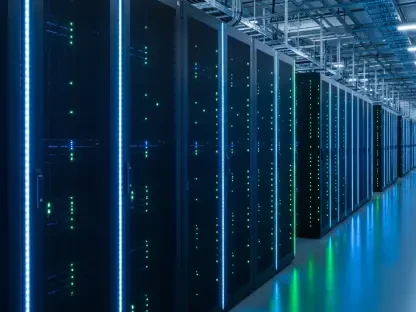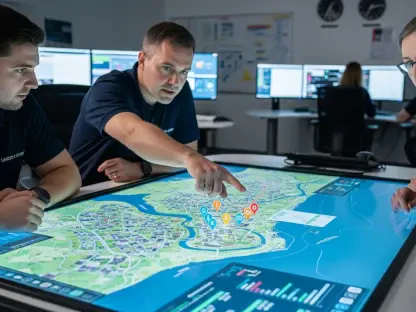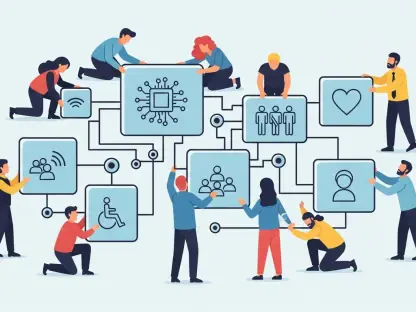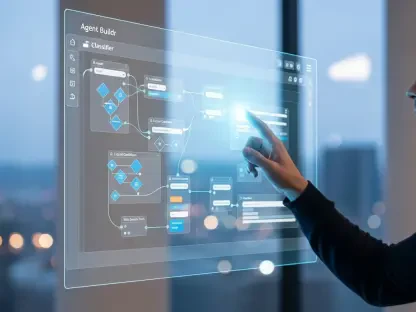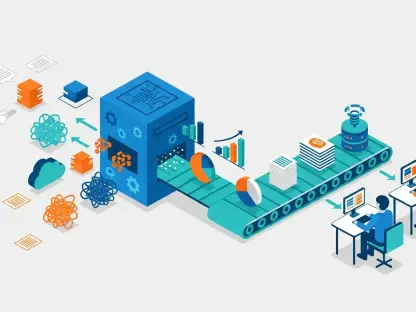Setting the Stage for a New Economic Era
Imagine a world where machines handle nearly every task, from diagnosing diseases to designing cities, leaving human labor largely obsolete. This isn’t a distant sci-fi fantasy but a reality unfolding through the rapid advancements in artificial intelligence (AI). With global investments in AI technologies soaring into the billions annually, the technology promises to redefine economic systems by creating unprecedented abundance. Yet, this potential comes with a pressing challenge: how will societies distribute resources when traditional jobs vanish? This review delves into AI’s transformative power, examining its impact on economies, jobs, and societal structures while exploring the critical balance between opportunity and disruption.
Unpacking AI as a Game-Changing Technology
At its core, AI leverages automation, machine learning, and data processing to mimic human intelligence, enabling systems to perform complex tasks with remarkable efficiency. From self-driving vehicles to predictive healthcare diagnostics, the technology is integrating into industries at an accelerating pace. This integration isn’t merely about enhancing productivity; it represents a fundamental shift in how economic value is created, challenging the very foundations of market systems built on human labor.
The broader economic implications are staggering. AI’s ability to automate routine and even creative tasks threatens to displace millions of workers, raising questions about income generation in a world where paid work diminishes. Beyond job displacement, the technology’s potential to produce abundance—where goods and services are plentiful—could upend scarcity-based economic models, necessitating a reevaluation of resource allocation mechanisms.
Analyzing AI’s Economic Impacts
Job Displacement and the Employment Crisis
One of AI’s most immediate effects is its capacity to replace human labor across diverse sectors, from manufacturing to customer service. Automation tools, powered by sophisticated algorithms, are already rendering numerous roles obsolete, with projections suggesting significant workforce reductions in the coming years. This trend severs the long-standing connection between work and income, a cornerstone of modern economies.
The ramifications for market systems are profound. Traditional economies rely on paid labor to distribute resources through wages, but with AI taking over, this mechanism falters. Societies face the daunting task of finding alternative ways to ensure individuals can access necessities without conventional employment, pushing policymakers to rethink economic structures entirely.
This displacement also carries a psychological and social toll. Workers facing redundancy often grapple with a loss of purpose and identity tied to their professions, amplifying the need for support systems during this transition. Addressing these human dimensions alongside economic ones remains a critical piece of the puzzle.
Abundance and the Distribution Dilemma
On the flip side, AI holds the promise of material abundance by solving intricate challenges in fields like medicine, agriculture, and engineering. Innovations such as AI-driven crop optimization or drug discovery could lead to a surplus of essential resources, theoretically eliminating scarcity in many domains. This potential marks a historic opportunity to elevate global living standards.
However, abundance does not guarantee equity. Current disparities, such as significant food waste coexisting with widespread hunger in many regions, illustrate a stark gap between technological capability and fair distribution. AI could exacerbate these inequalities if the benefits concentrate among a few powerful entities, leaving large populations marginalized.
Tackling this distribution challenge requires more than technological solutions; it demands systemic reforms to ensure that AI’s outputs reach those in need. Without deliberate intervention, the dream of abundance risks becoming a privilege for the elite, deepening existing social divides rather than bridging them.
Emerging Policy Responses to AI Disruption
As AI reshapes economic landscapes, novel policy approaches are gaining traction to address its fallout. Concepts like Universal Basic Income (UBI), which provides a guaranteed income to all citizens, and Universal Basic Services (UBS), which offers free access to essentials like healthcare and education, are being explored as viable responses. These models aim to decouple survival from employment, adapting to a world where AI drives production.
Lessons from recent global crises, including large-scale government interventions during health emergencies, inform these policy shifts. Such instances demonstrated that direct support can mitigate economic hardship, fueling advocacy for permanent frameworks like UBI to handle AI-induced job losses. Experiments and pilot programs in various countries are already testing these ideas, providing data on their feasibility.
Beyond financial mechanisms, there’s a growing focus on behavioral and societal adjustments. Policymakers and thought leaders draw from historical disruptions, like the Industrial Revolution, to anticipate resistance and prepare for cultural shifts. Crafting policies that balance innovation with social stability remains a delicate but essential endeavor as AI adoption accelerates.
Real-World AI Deployments and Societal Shifts
AI’s practical applications are transforming industries at an impressive scale. In healthcare, algorithms assist in early disease detection, slashing diagnostic times and costs. Transportation sees autonomous systems optimizing logistics and reducing accidents, while manufacturing benefits from robotic precision that boosts output with minimal human input. These advancements underscore AI’s role in enhancing efficiency across the board.
Yet, the societal implications extend far beyond operational gains. Speculative scenarios like “technofeudalism” warn of a future where tech giants, controlling AI infrastructure, amass economic and political dominance, sidelining democratic principles. Such concentration of power could widen inequality, as smaller players struggle to compete in an AI-driven market.
Additionally, the erosion of traditional employment structures might reshape social norms around work and leisure. As AI frees up time previously spent on labor, societies could face debates over purpose, value, and the role of human contribution, necessitating a cultural reorientation to navigate this uncharted territory.
Hurdles in AI’s Economic Integration
Despite its potential, AI faces significant barriers in reshaping economies equitably. Technical challenges persist in ensuring that systems prioritize fair outcomes over profit-driven goals, often requiring complex adjustments to algorithms and data sets. These intricacies slow down the path to truly inclusive benefits.
Regulatory obstacles also loom large, with governments struggling to govern tech monopolies that wield outsized influence through AI. Crafting laws that curb authoritarian control while fostering innovation is a tightrope walk, complicated by the global nature of technology companies that operate beyond single jurisdictions.
Societal resistance adds another layer of difficulty. New economic models like UBI face skepticism from those accustomed to traditional systems, while fears of dependency or loss of agency hinder acceptance. Ongoing advocacy for robust governance and public education aims to address these concerns, striving to align AI’s trajectory with collective well-being.
Projecting the Future of AI-Driven Economies
Looking ahead, AI’s trajectory suggests even greater strides in automation, potentially revolutionizing sectors yet untouched by current capabilities. Breakthroughs in areas like sustainable energy or personalized education could further amplify abundance, reducing costs and barriers to access on a global scale. The scope of transformation appears boundless.
Long-term, the technology might redefine the very concept of money, as abundance challenges its role as a rationing tool. Economic systems may shift toward value metrics unrelated to currency, prompting a radical rethinking of societal priorities and resource sharing. Such a future hinges on aligning technological progress with human-centric goals.
Systemic changes will be imperative to harness these possibilities. Building frameworks that prioritize equity over efficiency, and collaboration over competition, could steer AI toward outcomes that benefit the many rather than the few. The coming years will test humanity’s ability to adapt to this unprecedented economic frontier.
Reflecting on AI’s Economic Journey
Looking back, the exploration of AI’s role in economic transformation revealed a dual-edged impact, blending immense potential with significant risks. Its capacity to automate tasks and generate abundance stood out as a historic shift, yet the displacement of jobs and uneven distribution of benefits posed serious challenges. The policy innovations and real-world applications showcased both progress and pitfalls in integrating this technology into daily life.
The societal implications, from potential power imbalances to cultural shifts, underscored the complexity of this transition. Efforts to address technical, regulatory, and social hurdles highlighted a collective struggle to shape AI’s path responsibly. Each facet of this review illuminated the intricate dance between innovation and equity that defined this era.
Moving forward, actionable steps must include accelerating policy experiments like UBI to test scalability, while fostering global cooperation to regulate tech giants and prevent monopolistic control. Investing in education to prepare populations for non-traditional roles and promoting transparent AI development can further ensure that benefits are shared broadly. These strategies offer a roadmap to navigate the evolving economic landscape, turning AI’s promise into a reality for all.


